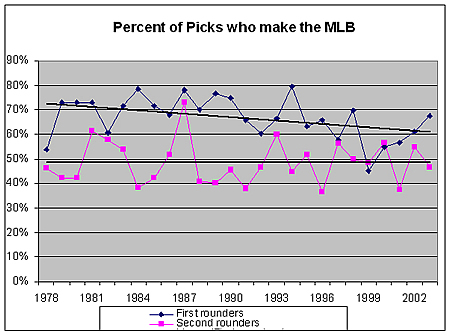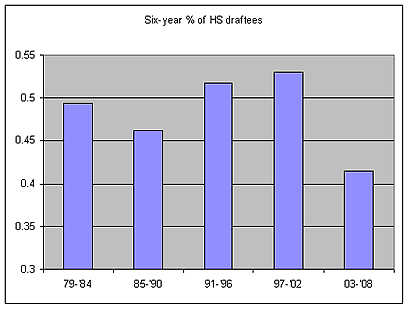BP Comment Quick Links

 | |
June 7, 2009 Prospectus Idol EntryTop Draft Picks: Where They Came From and Where They're GoingWhat do you know about what the baseball draft produces? Most fans probably have some sense of the history of their favorite team's high profile draft picks. For instance, I'm a Phillies fan, and most Phillies fans know that many of their current stars, such as Cole Hamels, Chase Utley, and Jimmy Rollins, are the result of the team's drafts. They also probably know enough to lament draft picks such as Jeff Jackson (picked ahead of Frank Thomas in 1989) and Ryne Sandberg (drafted in 1978 but then traded for Ivan DeJesus after only 13 games with the Phils). Fans might also know some random tidbit about other teams, such as the Mariners' successes with Ken Griffey Jr. and Alex Rodriguez or the Dodgers' drafting Mike Piazza 1,390th in the 1988 draft and getting a Hall of Famer. But beyond that, do you know much about what the draft as a whole produces? Because I fall into the same boat described above, I have been planning on researching the draft and the minor leagues for some time. Given that this week's topic is "Below the Big Leagues", now is as good a time as any to start. Without much readily available data, I researched the first two rounds of the last 31 amateur player drafts, compiled attributes that I felt were important, and then asked a series of questions that I found interesting. Like the start of any good research project, this initial analysis will create more questions than answers, but will serve to jumpstart future work. What's below is a discussion of some basic trends I've learned about the players drafted in the first two rounds since 1978. WHO MAKES THE MAJORS? The first question I wanted to ask was how frequently highly drafted players actually make it to majors. The majority of amateur players drafted will never set foot in a major league dugout. However, aren't first and second round picks different? In total, 51% of first and second rounds picks make the majors. Consider the following graph below. The blue line represents the percentage of first round draft picks each year that eventually made the majors (played at least one game), and the pink line represents the same for second round picks.
 Two things are pretty clear to me from this data. One is that first round selections do make the majors more than second round selections. It would be fair to say that to some extent teams do know what they are doing with these draft picks! The other thing that is clear is that fewer and fewer first round draft picks ever end up making the major leagues. Does that mean that teams are getting worse at identifying talent? I don't think so. Instead, the emergence of international players has grown rapidly during this time frame, resulting in more major league spots being taken up by non-drafted players. Interestingly, the trend is only downward for first round picks and not for second round picks. It would be worth checking how this pattern holds for later rounds. WHO IS SUCCESSFUL IN THE MAJORS? Next I went through the number of picks who achieved some level of success in the majors, rather than simply debuting at some point and fading away. I set up a pretty minimal definition of success-accumulating a WARP3 of 10.0 in their careers. Think Travis Lee (10.1) and Bruce Chen (9.1)-players who got some regular playing time over an extended period. I went through each set of five draft picks (picks 1-5, 6-10, etc.) and tabulated how many made the majors and how many had a WARP3 of 10.0 or above. Here is that chart: Picks: Made MLB WARP3>10 1-5 122 62 6-10 105 43 11-15 88 31 16-20 97 34 21-25 97 25 26-30 75 15 31-35 86 20 36-40 62 17 41-45 64 7 46-50 71 18 It does seem like teams are pretty good at identifying the top players in the draft. In fact, 28 of the last 31 first overall picks have made the majors, and 19 have WARP3s of at least 10.0. After that, while players with better chances seem to be drafted earlier, there is not a huge difference in between getting the 11th and 25th pick. DID MONEYBALL HAVE AN EFFECT ON THE DRAFT? Few books have changed baseball the way that Michael Lewis' "Moneyball" changed the game in 2003. In this book, Lewis documents the success of the Oakland A's, as they used economic theory to win with a small payroll. It has been well documented that teams put more value on OBP in a post-Moneyball world. However, another thing that Lewis discussed in detail was that in the draft, the A's targeted college players more than high school players, since college players had a higher chance of making the majors. What I found most interesting of all of my early results is the following: since 2003, there has been a sharp drop in the rate at which high school players are drafted in the first two rounds. From 1978-2002, teams drafted players out of high school in 51.3% of their first two rounds of picks. Suddenly, in 2003, only 40.3% of players drafted in the first two rounds came out of high school, and from 2003-2008, only 41.5% of players drafted in the first two rounds came directly from high school. There is no way to prove that this change was because of Moneyball. However, statisticians approach this problem by doing what is called a t-test. A t-test asks the following question: what is the probability that we would see such a significant change if this was nothing other than good old randomness? The answer to this question here? 0.003%! The chart below plots the percentage of players drafted in the first two rounds that were high school students in each set of six years from 1979-1984 up to 2003-2008.
 If something did change in MLB front offices as a result of Moneyball, there was good reason-from 1978 to 2008, 59% of players drafted in the first two rounds out of college made the majors, and only 42% of high school players. The counter-argument to the Moneyball idea of drafting college players is that high school players have higher upside and are more likely to succeed while in the majors. But research shows that's not true for the first two rounds. Of the college players drafted in the first two rounds, 17% of them reached a career WARP3 of 10.0, and only 12% of high school players did. It seems pretty clear that the A's must have known what they were doing. HOW OFTEN DO TEAMS TRADE AWAY MINOR LEAGUE SUPERSTARS-TO-BE? In 2008, Phillies pitcher Joe Blanton became the second pitcher since 1977 who was traded midseason and won a World Series game. (Can anybody name the first?) For all of the rampant trade rumors and discussions about making a move to get over the hump, it seems like the ultimate goal of those moves is rarely achieved. Of course, the Blanton example is a limited one, but it paints a pretty clear picture of how rarely midseason moves work out for contenders. One might take that to mean that contending teams are recklessly trading star prospects midseason for supposed difference makers who never materialize. Trades like the famous Mets' surrender of Scott Kazmir for Victor Zambrano stick out in our memories, but I decided to take a methodological look at how often teams actually made this mistake. It turns out that it is nearly as rare as those difference makers making a difference. Of the 2052 players in the study, 1041 of them made the majors. Of those, only 109 players were traded and then debuted with a different team than the one that had drafted them. Of that group of 109, only 19 accumulated a WARP3 of 10.0 in their careers. As it turns out, for all the fans who scream at GMs for trading away the farm system, rarely do the GMs trade away impact prospects. FURTHER THOUGHTS This is obviously just a starting point. It takes a long time to seriously look at a topic such as this (and easily longer to actually gather data!), but this is a good start. The interplay between the emergence of international stars and the success of early draft picks is certainly worth looking into further, and I will continue to study this. Looking at subsequent picks after the first two rounds will be interesting as well. Furthermore, it will be interesting to see if teams are more successful at drafting high schoolers now that they are more selective in doing so. That will take some time to study, but the information will eventually be available as the recent crop of high school draftees grow up. Naturally, the value of a trade of a star for a prospect is one of the hottest issues in the majors today. It is not useful to look at anecdotes to condemn or exalt a trade, but looking at this type of information more clearly will help determine where the trade market goes.
Matt Swartz is an author of Baseball Prospectus.
|
Once again, Matt really writes well and does great research. He's on topic, clear, and is the class of the field.
Except that a couple of his conclusions seemed a bit off. I immediately asked Rany Jazayerli, who's seminal work on the draft just a few years ago, seemed to contradict this in places. I asked Rany, who said "I wouldn't say he contradicts my series - the main finding of my work was that the high school/college pendulum swung the other way from 1992 to 1999, but since he's looking at the data all the way back to 1978, his conclusions that college players make for better draft picks are valid."
I wonder whether Matt has seen Rany's pieces and whether he really re-invented the wheel here. Part of that is the fault of BP and the sabermetric community at large, in really not having one central comparative database of the work out there. Regardless, this is another solid piece and Matt's not letting off the gas after lapping the field last week.